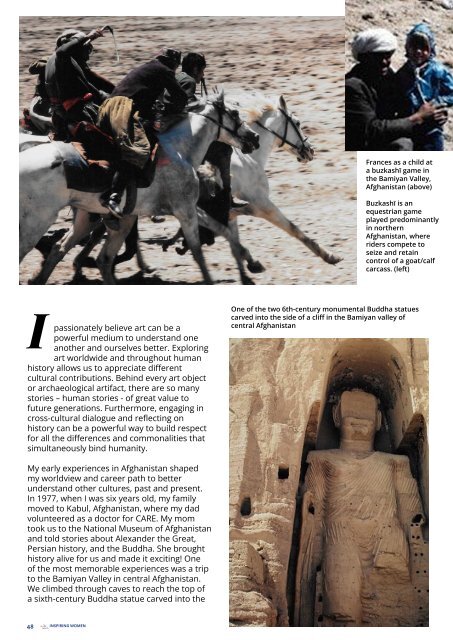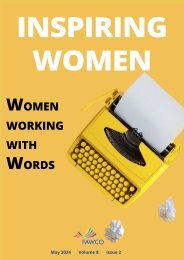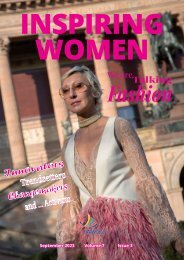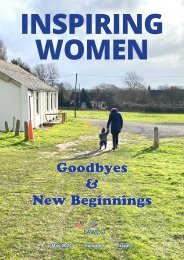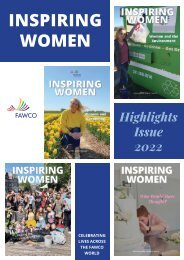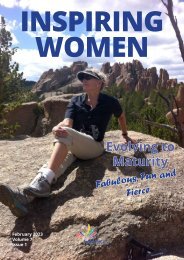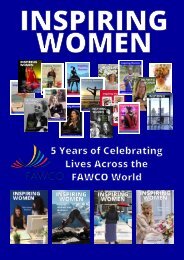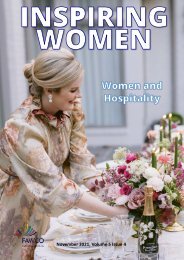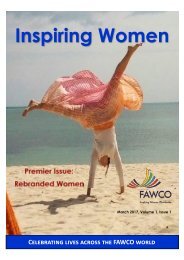Inspiring Women Magazine November 2023
Create successful ePaper yourself
Turn your PDF publications into a flip-book with our unique Google optimized e-Paper software.
Frances as a child at<br />
a buzkashī game in<br />
the Bamiyan Valley,<br />
Afghanistan (above)<br />
Buzkashī is an<br />
equestrian game<br />
played predominantly<br />
in northern<br />
Afghanistan, where<br />
riders compete to<br />
seize and retain<br />
control of a goat/calf<br />
carcass. (left)<br />
side of a cliff in the Bamiyan Valley of central<br />
Afghanistan. I remember holding the hands<br />
of my mom and older sister and gazing out<br />
at the Bamiyan Valley in complete wonder<br />
and awe. The world was a magical place,<br />
and I couldn't wait to see and learn more!<br />
When my family returned to Philadelphia my<br />
mother continued to nurture my interests in<br />
art and history, which led to a BA in Cultural<br />
Anthropology. I worked two years on an<br />
NGO project in Kenya revegetating semi-arid<br />
lands in the Lake Baringo and spent several<br />
summers on archaeological sites in southern<br />
Peru and museum conservation projects at<br />
the Museo Regional de Ica. My MA and PhD<br />
dissertations were based on my research<br />
of Nasca (100 BCE-600 CE) ceramics and<br />
textiles from the south coast of Peru. I will<br />
always cherish my time spent in Peru doing<br />
work I loved with incredible Peruvian friends<br />
and colleagues.<br />
Frances with two Peruvian hairless dogs. These dogs<br />
are a cultural heritage and fixture at many of Peru's<br />
coastal archaeological sites and museums.<br />
I<br />
passionately believe art can be a<br />
powerful medium to understand one<br />
another and ourselves better. Exploring<br />
art worldwide and throughout human<br />
history allows us to appreciate different<br />
cultural contributions. Behind every art object<br />
or archaeological artifact, there are so many<br />
stories – human stories - of great value to<br />
future generations. Furthermore, engaging in<br />
cross-cultural dialogue and reflecting on<br />
history can be a powerful way to build respect<br />
for all the differences and commonalities that<br />
simultaneously bind humanity.<br />
My early experiences in Afghanistan shaped<br />
my worldview and career path to better<br />
understand other cultures, past and present.<br />
In 1977, when I was six years old, my family<br />
moved to Kabul, Afghanistan, where my dad<br />
volunteered as a doctor for CARE. My mom<br />
took us to the National Museum of Afghanistan<br />
and told stories about Alexander the Great,<br />
Persian history, and the Buddha. She brought<br />
history alive for us and made it exciting! One<br />
of the most memorable experiences was a trip<br />
to the Bamiyan Valley in central Afghanistan.<br />
We climbed through caves to reach the top of<br />
a sixth-century Buddha statue carved into the<br />
One of the two 6th-century monumental Buddha statues<br />
carved into the side of a cliff in the Bamiyan valley of<br />
central Afghanistan<br />
In 2006, I moved to Berlin to marry<br />
my German husband Tilman and fell in<br />
love with Berlin's incredible museums<br />
and vibrant art scene. After working at<br />
museums and giving adult tours, I<br />
focused on art education for children.<br />
I create and teach multicultural art<br />
classes to connect kids to different art<br />
forms, styles, and traditions and design<br />
archaeology programs for students<br />
(ages 8-11) using art projects and<br />
hands-on STEM (Science, Technology,<br />
Engineering, and Math) challenges<br />
to learn about Ancient Egypt,<br />
Mesopotamia, China, the Romans<br />
and the Maya. It has been such an<br />
enriching experience taking these<br />
classes to elementary schools and<br />
after-school programs. I genuinely<br />
enjoy listening and learning from all<br />
my students' comments, questions,<br />
and insights.<br />
Classroom visit to teach primary school<br />
students about archaeology and our knowledge<br />
of the ancient past (top left)<br />
Ancient Egypt students made bookmarks on<br />
papyrus with their names written in hieroglyphics<br />
and decorated a mummy pencil case. (bottom left)<br />
48 INSPIRING WOMEN INSPIRING WOMEN 49


